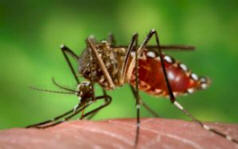
- Yellow fever is a tropical disease that is spread to humans by infected mosquitoes.

- Many yellow fever infections are mild, but the disease can cause severe, life-threatening illness.
- Yellow fever is found only in Africa and South America.
- Yellow fever is preventable by immunization. Travelers to countries with yellow fever should get the yellow fever vaccine.
- Many yellow fever infections are mild, but the disease can cause severe, life-threatening illness.
- Symptoms of severe infection are high fever, chills, headache, muscle aches, vomiting, and backache.
- After a brief recovery period, the infection can lead to shock, bleeding, and kidney and liver failure. Liver failure causes jaundice (yellowing of the skin and the whites of the eyes), hence the name yellow fever.
Dengue Fever
- Dengue fever is a flu-like illness spread by the bite of an infected mosquito. Dengue hemorrhagic fever is a severe, mostly fatal, complication of dengue fever
- Dengue fever usually starts suddenly with a high fever, rash, severe headache, pain behind the eyes, and muscle and joint pain.
- The severity of the joint pain has given dengue the name "breakbone fever." Nausea, vomiting, and loss of appetite are common.
- A rash usually appears 3 to 4 days after the start of the fever. The illness can last up to 10 days, but complete recovery can take as long as a month.
- Most dengue infections result in relatively mild illness, but some can progress to dengue hemorrhagic fever.
- In dengue haemorrhagic fever, the blood vessels start to leak and cause bleeding from the nose, mouth, and gums. Bruising can be a sign of bleeding inside the body. Without prompt treatment, the blood vessels can collapse, causing shock (dengue shock syndrome).
- Dengue hemorrhagic fever is fatal in about 5 percent of cases, mostly among children and young adults.
- The time between the bite of a mosquito carrying dengue virus and the start of symptoms averages 4 to 6 days, with a range of 3 to 14 days.
- An infected person cannot spread the infection to other persons but can be a source of dengue virus for mosquitoes for about 6 days.
 mosquitoes have to lay eggs. Aerate birdbaths and make sure gutters are
free of blockages. Clean pet bowls everyday and always empty overflow
dishes for potted plants.
mosquitoes have to lay eggs. Aerate birdbaths and make sure gutters are
free of blockages. Clean pet bowls everyday and always empty overflow
dishes for potted plants.Use of Mosquito nets
Long sleeved clothing, especially after dusk
Mosquito sprays (insecticide).